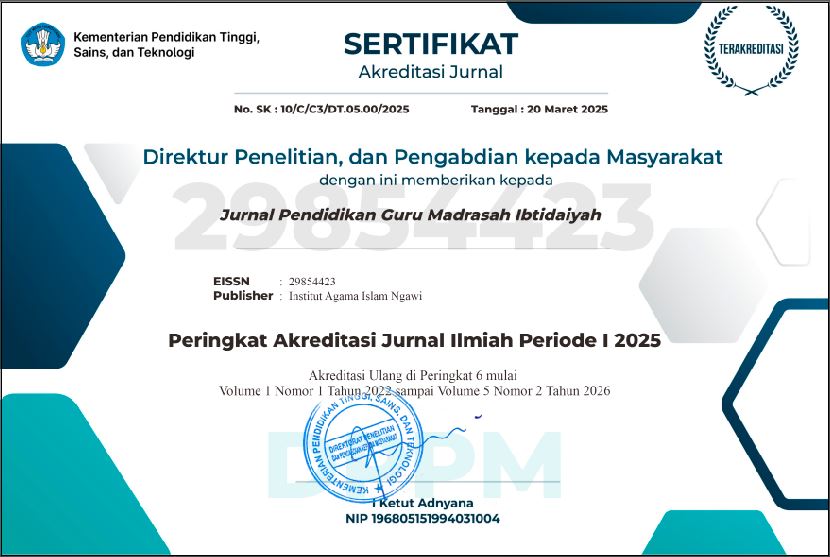IDENTIFIKASI PENYEBAB KENAKALAN SISWA DI SEKOLAH DASAR Mi BABUSSALAM KECAMATAN PASONGSONGAN
DOI:
https://doi.org/10.56997/pgmi.v3i1.1537Keywords:
Delinquency, students, elementary schoolAbstract
Student bad behavior refers to behavior or actions that can cause problems, harm individuals or other people, and violate ethical and social standards. The purpose of this research is to determine the causes of naughty behavior in class IV Mi Babussalam students, and the types of mischief committed by class IV Mi Babussalam students. This research is qualitative in nature and involves the use of a case study model. This research was conducted at Mi Babussalam Pasongsongan Sumenep. This research focuses on student bad behavior (delinquency). Information collection includes interview notes, observation sheets, and documents. Data analysis is based on the Miles and Huberman model, with data collection as the main methodology for collecting information, presenting it as output, analyzing state-of-the-art data using quantitative methods, and drawing conclusions. The validity of the data was verified through source triangulation techniques. Research shows that student misbehavior includes behaviors such as fighting, teasing, and ignoring school policies. These bad actions are not only caused by the students themselves but can also be the result of the influence of their families or the surrounding environment, such as a poor environment, lack of attention from parents, and disharmony within the family. A common form of student bad behavior is causing the classroom environment to become chaotic or disorganized by using dirty words to manipulate their friends so that fights occur. To deal with student bad behavior, teachers and schools can use actions such as warnings, sanctions, and letters of agreement to students not to repeat this again. This is done with the aim of creating a deterrent effect that prevents bad behavior from occurring in the future. Preventing student misbehavior requires joint efforts between educators and families, as well as a review of school programs.
References
Bujuri. A. D. (2018). Analisis Perkembangan Kognitif Anak Usia Dasar Dan Implikasinya Dalam Kegiatan Belajar Mengajar, Jurnal LITERASI, Vol. 9, No. 1, 38. https://ejournal.almaata.ac.id/index.php/LITERASI/article/view/720/0
Syafaruddin, Asrul , dan Mesiono. (2012). Inovasi Pendidikan: Suatu analisis Terhadap Kebijakan Baru Pendidikan, (Medan: Perdana Publishing), 178.
Saputra. R, Komairah. K. (2020). Peran Guru Bk Dalam Mengatasi Kenakalan Siswa, IjoCE (Indonesian Journal of Counseling and Education) Vol. 1, No. 2, 24 – 25 https://jurnal.lp2msasbabel.ac.id/index.php/IJoCE/article/view/1962
Gularso, D., & Indrianawati, M. (2022). Kenakalan siswa di sekolah dasar. Taman Cendekia: Jurnal Pendidikan Ke-SD-an, Vol. 6, No. 1, 2022, 14-22 www.jurnal.ustjogja.ac.id/index.php/tamancendekia/article/download/12205/5084/27835
Qaimi. A, Author. (2004). "Keluarga dan anak bermasalah." Bogor: Cahaya. URI: https://lib.ui.ac.id/detail.jsp?id=30645
Dea, Fasha. G. (2019). Implementasi pendidikan karakter religius dalam menanggulangi kenakalan siswa Sekolah Dasar: Studi multisitus di MI Plus Al Azhar dan SDN Babadan 01 Wlingi Blitar (Doctoral dissertation, Universitas Islam Negeri Maulana Malik Ibrahim). http://etheses.uin-malang.ac.id/42940/
Wahyuni. (2020). KOMUNIKASI KELUARGA DALAM MENCEGAH KENAKALAN REMAJA DI DESA BANDAN HURIP KECAMATAN PALAS KABUPATEN LAMPUNG SELATAN (Doctoral dissertation, UIN Raden Intan Lampung). http://repository.radenintan.ac.id/9446/1/PUSAT%201%202.pdf
Novita, N. P. (2012). Hubungan antara kekerasan emosional pada anak terhadap kecenderungan kenakalan remaja (Doctoral dissertation, UNIVERSITAS AIRLANGGA). https://repository.unair.ac.id/107258/
Willis, Sofyan .S. (2008). Remaja & masalahnya: mengupas berbagai bentuk kenakalan remaja seperti narkoba, free sex dan pemecahannya. Alfabeta.
Sugiyono. (2016). Metode Penelitian Kuantitatif Kualitatif dan R&D. Alfabeta.
Samsudin. S, Asrofi. A. (2021). Hukuman Dalam Pendidikan Islam: Studi Atas Dampak Psikologis Anak Usia Dasar Dan Citra Guru, Tarbiyatuna: Jurnal Pendidikan Islam, Vol. 14, No. 2 https://doi.org/10.36835/tarbiyatuna.v14i2.892
Ichsan. S. A. (2019). “Revisiting the Value Education in the Field of Primary Education”, Elementary: Jurnal Ilmiah Pendidikan Dasar, vol. 5, no. 2, 149 https://doi.org/10.32332/elementary.v5i2.1643
Samsudin. S. (2014) “Relevansi Hukuman dalam Pembelajaran Humanis Religius”, An-Nur: Jurnal Studi Islam, vol. 6, no. 1, 81.
Murray, J, and Farrington. P. D (2010). "Risk factors for conduct disorder and delinquency: Key findings from longitudinal studies." The Canadian Journal of Psychiatry , vol. 55, no. 10, 633-642 https://doi.org/10.1177/070674371005501003
Khotimah, N. (2024). STRATEGI GURU MENGATASI PERILAKU DISRUPTIF SISWA DALAM PEMBELAJARAN DI SEKOLAH DASAR. Jurnal Jaringan Penelitian Pengembangan Penerapan Inovasi Pendidikan (Jarlitbang), vol. 10, no. 1, 49-60. https://jurnal.wonogirikab.go.id/jarlitbang
Alkhasanah. N, Darsinah, Ernawati. (2023). "PERAN GURU DALAM MEMBENTUK KARAKTER SISWA SD." Jurnal Ilmiah Pendidikan Citra Bakti, vol. 10, no .2, 355-365 https://doi.org/10.38048/jipcb.v10i2.1271
Fissel, E. R., Wilcox, P., & Tillyer, M. S. (2019). School discipline policies, perceptions of justice, and in-school delinquency. Crime & Delinquency, vol. 65, no. 10, 1343-1370. https://doi.org/10.1177/0011128718794186
Arifin. A, Sugerman. S, Amin. m. (2021). “Respon Guru Terhadap Pelanggaran yang Dilakukan Siswa (Studi Kasus di SDN 10 Pajo).” Jurnal Ainara (Jurnal Penelitian dan PKM Bidang Pendidikan, vol. 2, no. 3. 193-205. https://doi.org/10.54371/ainj.v2i3.81
Handayani, H. L., Ghufron, S., & Kasiyun, S. (2020). Perilaku negatif siswa: bentuk, faktor penyebab, dan solusi guru dalam mengatasinya. Elementary School: Jurnal Pendidikan Dan Pembelajaran Ke-SD-An, vol. 7, no. 2 10.31316/esjurnal.v7i2.760
Afiyani, I., Wiarsih, C., & Bramasta, D. (2019). Identifikasi Ciri-Ciri Perilaku Bullying Dan Solusi Untuk Mengatasinya Di Sekolah. Jurnal Mahasiswa BK An-Nur : Berbeda, Bermakna, Mulia, vol. 5, no. 3, 21–25 https://ojs.uniska-bjm.ac.id/index.php/AN-NUR/article/view/2433
Malihah, E., Wilodati, & Jerry, G. L. (2014). KENAKALAN REMAJA AKIBAT KELOMPOK PERTEMANAN SISWA. Forum Ilmu Sosial, vo. 41, no. 1, 15–27. https://doi.org/10.15294/fis.v41i1.5373
Marwanti, E., Setyawan, A. D., & Rezkita, S. (2018). Implementasi penanaman karakter anak dalam syair lagu dolanan anak cublak-cublak suweng. Taman Cendekia: Jurnal Pendidikan Ke-SD-an, vol. 2, no. 2, 251–256 www.jurnal.ustjogja.ac.id/index.php/tamancendekia/article/view/3073
Polanin, J. R., Espelage, D. L., Grotpeter, J. K., Spinney, E., Ingram, K. M., Valido, Alberto, Sheikh. E, America,Torgal, Cagil, Luz ,& Robinson. (2021). A meta-analysis of longitudinal partial correlations between school violence and mental health, school performance, and criminal or delinquent acts. Psychological bulletin, vol. 147, no. 2, 115. https://psycnet.apa.org/buy/2020-91555-001
Obsuth, I., Murray, A. L., Knoll, M., Ribeaud, D., & Eisner, M. (2023). Teacher-student relationships in childhood as a protective factor against adolescent delinquency up to age 17: A propensity score matching approach. Crime & Delinquency, 69(4), 727-755. https://doi.org/10.1177/00111287211014153
Downloads
Published
Issue
Section
License
Copyright (c) 2025 Dauri Aziz, Sulhan

This work is licensed under a Creative Commons Attribution 4.0 International License.
Jurnal PGMI : Jurnap Pendidikan Guru Madrasah Ibtidaiyah CC-BY or an equivalent license as the optimal license for the publication, distribution, use, and reuse of scholarly work.







